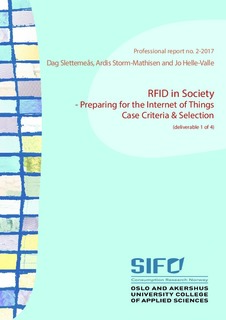| dc.contributor.author | Slettemeås, Dag | |
| dc.contributor.author | Storm-Mathisen, Ardis | |
| dc.contributor.author | Helle-Valle, Jo | |
| dc.date.accessioned | 2020-06-21T15:28:21Z | |
| dc.date.accessioned | 2021-04-29T12:43:19Z | |
| dc.date.available | 2020-06-21T15:28:21Z | |
| dc.date.available | 2021-04-29T12:43:19Z | |
| dc.date.issued | 2017 | |
| dc.identifier.isbn | 82-7063-464-6 | |
| dc.identifier.uri | https://hdl.handle.net/20.500.12199/5338 | |
| dc.description.abstract | This is the first of four reports from the RCN-financed project RFID in Society – Preparing for the Internet of Things (2010- 2017). In addition to articles, conference papers, an exhibition, presentations, media contributions and a project website , the project has published the following reports: Del. 1 of 4: “Case Criteria & Selection”; Del. 2 of 4: “Case Analyses & Evaluation”; Del. 3 of 4: “Handbook of Methods”; and Del. 4 of 4: “Final Report & Summary”. This first report addresses the first research task of the RFID in Society project, namely to identify and map what types of technology/systems/applications (and related products/services) the project should focus on. This was necessary since the “RFID/IoT territory” was relatively unchartered at the time of project initiation (2010). The approach followed an exploratory/descriptive “multiple case-study” design of people-centric RFID/IoT-services. As part of the mapping process, the research team needed to identify criteria for both selecting cases and for organising them. This was done in a partly grounded fashion, including literature study of existing cases from academic studies, desk research of cases using various search engines/search specifications, and through several workshops/deliberations discussing relevant aspects. In this way, the project group managed to identify a range of criteria for organising relevant cases. Then a process of selecting relevant criteria followed, through an iterative process of adding/excluding criteria, and specifying these in a tree-shaped structure. This exercise started with user roles (related to relevant technologies/applications), then generic activities, specific activities/services, and eventually functions/benefits were added. Based on the structure and ideas generated from these iterations, the next step in search for relevant cases was to narrow down our focus to specific cases in the Norwegian context. Hence, the project group first gathered information about relevant cases at that time (primarily in the period around 2010-2012), showed diversity with respect to different aspects (public/commercial, pilots/implemented, small-scale/large-scale, simple tech/larger system, etc.). Initially, 20-30 different cases were explored. Through a funneling approach we gradually eliminated potential cases one by one, as they were found to be incompatible with our design. From this iterative investigation and exclusion process, we ended up with 13 cases to be explored further. All cases were first arranged in a simplified template, where only a few key criteria were used (in order to provide an accessible introduction to the cases). By following the simplified template, and adding insights from the previous iterative tree-structuring process, we developed an extended template for case description. Finally, information about the 13 cases were filled in the table system of the extended template. | en |
| dc.description.abstract | This is the first of four reports from the RCN-financed project RFID in Society – Preparing for the Internet of Things (2010- 2017). In addition to articles, conference papers, an exhibition, presentations, media contributions and a project website , the project has published the following reports: Del. 1 of 4: “Case Criteria & Selection”; Del. 2 of 4: “Case Analyses & Evaluation”; Del. 3 of 4: “Handbook of Methods”; and Del. 4 of 4: “Final Report & Summary”. This first report addresses the first research task of the RFID in Society project, namely to identify and map what types of technology/systems/applications (and related products/services) the project should focus on. This was necessary since the “RFID/IoT territory” was relatively unchartered at the time of project initiation (2010). The approach followed an exploratory/descriptive “multiple case-study” design of people-centric RFID/IoT-services. As part of the mapping process, the research team needed to identify criteria for both selecting cases and for organising them. This was done in a partly grounded fashion, including literature study of existing cases from academic studies, desk research of cases using various search engines/search specifications, and through several workshops/deliberations discussing relevant aspects. In this way, the project group managed to identify a range of criteria for organising relevant cases. Then a process of selecting relevant criteria followed, through an iterative process of adding/excluding criteria, and specifying these in a tree-shaped structure. This exercise started with user roles (related to relevant technologies/applications), then generic activities, specific activities/services, and eventually functions/benefits were added. Based on the structure and ideas generated from these iterations, the next step in search for relevant cases was to narrow down our focus to specific cases in the Norwegian context. Hence, the project group first gathered information about relevant cases at that time (primarily in the period around 2010-2012), showed diversity with respect to different aspects (public/commercial, pilots/implemented, small-scale/large-scale, simple tech/larger system, etc.). Initially, 20-30 different cases were explored. Through a funneling approach we gradually eliminated potential cases one by one, as they were found to be incompatible with our design. From this iterative investigation and exclusion process, we ended up with 13 cases to be explored further. All cases were first arranged in a simplified template, where only a few key criteria were used (in order to provide an accessible introduction to the cases). By following the simplified template, and adding insights from the previous iterative tree-structuring process, we developed an extended template for case description. Finally, information about the 13 cases were filled in the table system of the extended template. | no_NB |
| dc.publisher | Høgskolen i Oslo og Akershus | |
| dc.relation.ispartofseries | Professional report nr. 2-2017 | |
| dc.subject | SIFO, PublikasjonSIFO, RapporterSIFO | |
| dc.title | RFID in Society – Preparing for the Internet of Things Case Criteria & Selection Part 1 of 4 | no_NB |
| dc.type | Research report | |
| fagarkivet.author.link | https://www.oslomet.no/om/ansatt/valle/ | |
| fagarkivet.source.pagenumber | 57.0 | |
